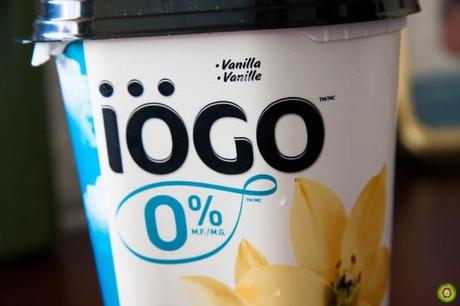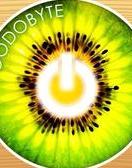You’ve probably seen giant billboards plastered around the city advertising this particular product. It paints itself as a natural, low-calorie, fat-free and sugar-free yogurt that still tastes great and provides health benefits. This yogurt, of course, is the brainchild of IÖGO.

Curious, I bought a carton of IÖGO’s 0% Vanilla Yogurt. To be honest, I only ate a couple spoonfuls before I decided it wasn’t for me. After eating Liberte Greek yogurt for a while, I found IÖGO to taste very artificial, in spite of its “natural ingredients.” Here’s a excerpt from IÖGO’s F.A.Q.:

However, if you scroll further down, or look at the carton itself, you’ll see that the yogurt has Sucralose, an artificial sweetener derived from sugar. Is sweetness not a flavor nowadays? As a side note, Splenda is Sucralose.
Since aspartame, another synthetic sweetener, is notorious for its adverse impact on health, I was interested to see if Sucralose induced the same effects…

What is Sucralose?
As I said before, Sucralose is derived from sucrose, commonly known as sugar. Scientists accomplish this feat by substituting three hydroxyl groups (circled in blue) with three chlorine groups (circled in red). Thus, not only is Sucralose indigestible by the body, but also it is 600 times sweeter than sugar! This means that you only need minute amounts of Sucralose to sweeten up your coffee… and it’s zero calories.
You might be wondering why Sucralose is so sweet. Well, the displacement of chlorine causes a conformational change in the molecule, which exposes its “sweet spot” and allows it to bind to a “sweetness receptor” more easily than sugar. In metaphorical words, sucrose is a banana while Sucralose is a peeled banana, which is easier and tastier to eat!
Once you ingest Sucralose, 85% of it leaves your body within 24 hours when you pee. The remaining 15% is completely excreted over the following few days, which is a good thing because there’s no bioaccumulation in your body.
Is it bad for your brain?
Aspartame caused quite a commotion because it triggered long-term health effects such as headaches, migraines, epilepsy and bi-polar disorder (no, not bi-winning). Sucralose, on the other hand, has not exhibited any kind of neurotoxicity… or at least not in mice, rats and marmoset monkeys. Sucralose is biologically inactive because it’s not metabolized to 6-chlorohexose, a chlorinated sugar molecule that does express neurotoxic effects. Some of the hypothesized mechanisms of 6-chlorohexose are:
- It interferes with glucose and sodium transport across the membranes of male reproductive organs;
- Along those same lines, it interferes with sperm glycolysis (resulting in less energy for sperm);
- Finally, it competes with glucose in the brain
When a pregnant mother consumes Sucralose, is the baby affected?
In a nutshell, no. In experiments that involved rats and rabbits, Sucralose was not observed to cross the placenta, and thereby not having an impact on the infant.
Does it affect your manhood like Mountain Dew?
Again, no! Although molecules that are similar to Sucralose have been observed to affect the fertility of male rats, that’s not the case for Sucralose itself. In an experiment, male and female rats were fed copious amounts of Sucralose 10 weeks before mating. Scientists continued this kind of treatment for the following two generations. Ultimately, based on all reproductive indices (oestrous cycles, mating behaviour, fertiliy, gestation, maternal and foetal viability, foetal development, parturition, pup maturation and lactation), it was concluded that Sucralose was no different from the control group. That is, it had no effect on male or female reproductive abilities.
What about the rest of the body?
Consuming 3000 mg/kg body weight of Sucralose every day will result in inefficient nutrient absorption. Some other effects include caecal enlargement (ie: the beginning of your large intestine gets even larger), increased kidney weight, and overall weight loss. Scary, eh?
Well, 3000mg/kg/day may be hard to visualize… so, I’ll put it in perspective! But first, let me say that the No-Observed-Effect-Level (NOEL) for Sucralose is 1500mg/kg/day. This means that, in an experiment, a rat consumed the maximum of 1500mg/kg/day of Sucralose before displaying any adverse heath effects.
Okay, time to clarify the numbers!
- A 160lb adult would have to drink 1500 cans of diet coke per day to approach the NOEL;
- Since IÖGO yogurt has 19mg of Sucralose per 100g, the same adult would need to devour 12 cartons (650g)!
Evidently, you would need to consume a lot of yogurt and diet soda to experience any negative health effects. Nevertheless, the FAO/WHO Joint Expert Committee established the Acceptable Dietary Intake (ADI) level for Sucralose at 15mg/kg/day. Effectively, this is a 100-fold safety margin, so there’s plenty of room for people to screw up!
My thoughts?
Sucralose-sweetened products provide a good alternative for diabetics and individuals with PKU. However, try not to feed your children with these foods because… they need to grow! They need the calories!
And if you’re still in doubt, just stay away from it. Although Sucralose is deemed safe by current research, I’d much rather stick to foods that are actually sweetened with natural ingredients. Who cares if there’s some sugar? Burn it off with some exercise! Besides, Greek yogurt + Granola = Awesome.
Sources:
- Acute and subchronic toxicity of sucralose. http://bit.ly/Xb1RDq
- Sucralose: lack of effects on sperm glycolysis and reproduction in the rat. http://bit.ly/Xb1UiB
- Effect of the artificial sweetener, sucralose, on gastric emptying and incretin hormone release in healthy subjects. http://bit.ly/SX9Flq
- Neurotoxicity studies on sucralose and its hydrolysis products with special reference to histopathologic and ultrastructural changes. http://bit.ly/SX9zKL
- Sucralose: An Overview. http://bit.ly/SX9Ehs
- Sucralose: lack of effects on sperm glycolysis and reproduction in the rat. http://1.usa.gov/SX9AhQ

